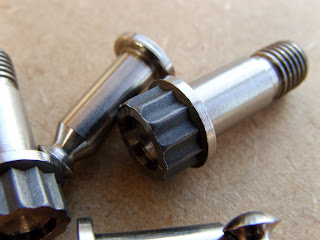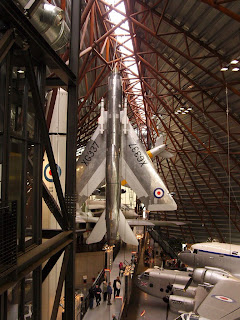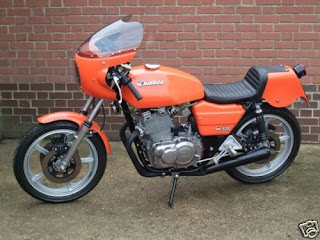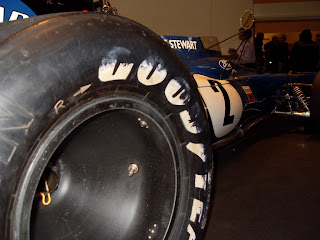Like it.
Sunday 31 January 2010
Saturday 30 January 2010
Titanium fittings
These were manufactured for the TSR2 (I was going to do a link here but just Google it, there's masses). Spare parts and never used and now for sale in the gift shop at RAF Hendon and Cosford and possibly elsewhere. 50p each. The TSR2 was to be the UK's first hypersonic fighter/bomber but was cancelled in 1965, so these may be as old as me and may have been made by one of my uncles.
Montesa 150
Don't know anything much about these, apart from it's a pretty little bike and it's in Barcelona and on eBay.
English Electric Lightning
In the Cold War hangar at RAF Cosford. Sometime in the late 60's I was taken to an airshow at RAF Church Fenton, I was 5 or 6 years old. All I remember is an image like this. We were stood about 50m from the runway watching a Lightning approach for landing. Just a couple of metres from touchdown the pilot opened the throttle, stood the plane on its tail and dissapeared vertically. I believe that for decades it had the fastest climb rate of any vehicle except the Saturn V rocket. GL to 1 mile in around 10 seconds. The noise was tremendous. It's still one of the most exciting things I have ever seen.
Monday 25 January 2010
Friday 22 January 2010
Post's arrived
The order from Amal arrived this morning and the 140 jet was fitted immediately. Runs much better, smoother tickover, cleaner pickup, less smoke and the plug is less sooty. But it is still sooty and I could probably have gone for a 130. Maybe as it burns off all the old carbon it will clean up?
Wednesday 20 January 2010
New bike (in 1989)
After its first ever run. Light coating of brake dust on the front rim, slight rain streaks along the fairing, ticking gently as it cools. I can still smell it.
Amal 2627
The carburettor off the 348 runs rich, unsurprisingly after thirty years it's rather worn. The main problem is the slide which gets pulled against the inlet tract. Eventually the cylindrical face wears with a notch and easing it down with a file smooths the movement but leaves it even looser. Apparently the bore wears at the same rate so replacing the slide is pointless. Time for a new carb. Except I want to keep this on the bike and make it last just a bit longer. So last night I sat down at the kitchen table, pulled it apart and ordered a 140 main jet (down from 150) from Amal. At £3 it's a cheap solution. I'll post if it works, or not.
Monday 18 January 2010
Saturday 16 January 2010
Friday 15 January 2010
Thursday 14 January 2010
Design Classic
Several years (decades when I come to think of it) ago I wrote a piece for a well known design magazine. The mag ran a back page on design classics and asked for something on the Vincent Black Shadow. I winced a bit, it's just so obvious and the provenance of so many is in doubt. It's rumoured thet there are more existing now than were ever built in Stevenage. Talking to a friend about this, he suggested that the Honda C50 is more venerable. We laughed, but he was right. The magazine wasn't pleased and edited it a lot, so this has never been published.
-----
The Honda C50. A small step through commuter vehicle, aimed at the world market and both sexes, is I'm afraid a tedious little moped. But since its launch in the mid 1950 it's outsold everything. Forget the image of cruising and knee sliders. Harley's and Ducati's are all very well, but not every day.
But now the C50 is discontinued. No longer desired by the performance freaks of the 90's, it has been superseded by the C70 and C90. The moped has suffered from legislation. With its speed restricted to a safe 30 mph, it became a grinding bore.
The construction was unusual for its time. Ignoring the fashion for a tubular frame and pressed body work, Honda chose to develop a pressed steel frame and injection moulded plastic body work. In terms of style there isn't much to admire. The early models, upto the late sixties are more desirable. In the way that early VW's might be.
The small two valve four stroke engine was developed specially for this bike and it is still essentially unchanged in its successors. Hanging the engine below the beam frame and between the riders feet aided stability. Having set the fuel tank and electrics under the seat, space is left to step through. Ideal for those in a skirt or sarong. It was truly asexual and international.
Motorcycle manufacture is an exceptional business. It suffers extremes of niche marketing. From taxi drivers doing the knowledge to noisy adolescents and dispatchers, cruisers, fifty's revivalists, street racers, leather fetishists of the gay scene, Angels and all the rest. But we all started at the C50, or there abouts.
Saturday 9 January 2010
KTM koncepts
Could do with one of these at the moment...
but this hovercraft/helicopter/bike thing would be even better.
Manx or International?
Beatrice Shilling rode a Manx Norton, according to Wikipedia and other published information. Except, I don't think it was, the date isn't right and a few small details suggest a modified International. I asked Paul Norman at http://www.racingvincent.co.uk/ who knows more than I do, this is his reply.
----------
Hi Jeremy,
Thanks for sending me this, a very nice period photo (he refers to the photo in the previous post), taken at Brooklands from the Campbell circuit if I am not mistaken. The rider looks vaguely familiar but not really sure.
The photo is titled Beatrice Shilling 35, so I guess that is who it is and the date, but I suspect the bike is actually slightly earlier than that.
With the very early cammy Nortons it is actually a bit more difficult to identify the Inter's from Manx's as the differences were quite subtle but by about 34-35 the racing versions had become well established, with magnesium crankcases of a particular shape and layout.
The 'Manx Spec' tag was used pre-war (I have one myself), but in the early 1930's the early versions were not really coined Manx's, they were normally referred to as Racing Specification International's.
I would say this bike is one of these pre Manx racing Nortons. The tank is International from a road going model, but the main giveaway is the nut on the cambox cover, that shows it is an early racing cambox, with central oil feed. The gearbox has the early 'thatched roof' type gearchange cover, that indicates to me it is probably 32-33 in manufacture. I also have an idea that the crankcases look like magnesium, although they are of International pattern. However, this would be correct for the very first type of 'racing' crankcases, which were a sort of hybred of the Intnernational crankcase (that remained almost unchanged until the mid '50's) and the pure 'Manx' style SOHC racing magnesium crankcase that came in in about 34-35. I am currently importing a set of these very rare interim racing crankcases from Australia, although my set have many holes scattered around their circumference, where a conrod has made a bid for freedom!
Also of interest is the carburettor, which is downdraught but twin float, meaning it is probably on alchohol. Forks, front wheel and handlebars are all 'proper' for a genuine Brooklands bike, as is the exhaust, so I would think this is a genuine racing Norton, although due to its early date of manufacture, it probably would not have been regarded as a 'Manx spec' bike at that time.
I am pretty sure that Beatrice Shilling was one of the earliest female Brooklands enthusiasts, but I am not sure if this would have been her bike or one that she had 'loaned' for select events.
----------
Regarding Paul's last comment; it is certain that it is her bike, she was a skilled engineer and quite capeable of maintaining and rebuilding a bike like this. As I mentioned in my last post, she built her own supercharger for the bike. She was at the forefront of motorcycle racing, a fact recognised by Norton who used her bike for publicity photos.
Many thanks to Paul for such a detailed explanation of Manx history.
----------
Hi Jeremy,
Thanks for sending me this, a very nice period photo (he refers to the photo in the previous post), taken at Brooklands from the Campbell circuit if I am not mistaken. The rider looks vaguely familiar but not really sure.
The photo is titled Beatrice Shilling 35, so I guess that is who it is and the date, but I suspect the bike is actually slightly earlier than that.
With the very early cammy Nortons it is actually a bit more difficult to identify the Inter's from Manx's as the differences were quite subtle but by about 34-35 the racing versions had become well established, with magnesium crankcases of a particular shape and layout.
The 'Manx Spec' tag was used pre-war (I have one myself), but in the early 1930's the early versions were not really coined Manx's, they were normally referred to as Racing Specification International's.
I would say this bike is one of these pre Manx racing Nortons. The tank is International from a road going model, but the main giveaway is the nut on the cambox cover, that shows it is an early racing cambox, with central oil feed. The gearbox has the early 'thatched roof' type gearchange cover, that indicates to me it is probably 32-33 in manufacture. I also have an idea that the crankcases look like magnesium, although they are of International pattern. However, this would be correct for the very first type of 'racing' crankcases, which were a sort of hybred of the Intnernational crankcase (that remained almost unchanged until the mid '50's) and the pure 'Manx' style SOHC racing magnesium crankcase that came in in about 34-35. I am currently importing a set of these very rare interim racing crankcases from Australia, although my set have many holes scattered around their circumference, where a conrod has made a bid for freedom!
Also of interest is the carburettor, which is downdraught but twin float, meaning it is probably on alchohol. Forks, front wheel and handlebars are all 'proper' for a genuine Brooklands bike, as is the exhaust, so I would think this is a genuine racing Norton, although due to its early date of manufacture, it probably would not have been regarded as a 'Manx spec' bike at that time.
I am pretty sure that Beatrice Shilling was one of the earliest female Brooklands enthusiasts, but I am not sure if this would have been her bike or one that she had 'loaned' for select events.
----------
Regarding Paul's last comment; it is certain that it is her bike, she was a skilled engineer and quite capeable of maintaining and rebuilding a bike like this. As I mentioned in my last post, she built her own supercharger for the bike. She was at the forefront of motorcycle racing, a fact recognised by Norton who used her bike for publicity photos.
Many thanks to Paul for such a detailed explanation of Manx history.
Thursday 7 January 2010
Tilly Shilling's Orifice
My wife is a member of the Women's Engineering Society. One of the society's earliest members was Beatrice Shilling, pictured here (in the mid 1930's) with her Manx 500 on which she became the first woman to lap Brooklands at over 100mph. She later added her own homemade supercharger in that inevetable search for more power. The supercharger didn't work that well but it helped in bringing her to the attention of the Royal Aircraft Establishment who employed her as a scientific officer and charged her with the task of resolving a fueling problem with the Rolls Royce Merlin aero engine. This engine was used in more than 40 different planes but most famously in the Supermarine Spitfire and Hawker Hurricane. However, with a normal carburettor it suffered fuel starvation in negative g and this meant it was unable to turn the nose down into a dive in straight flight. To avoid this pilots put the plane into a half roll and let it drop sideways before pulling up and turning back onto the original course. Despite being faster than the German planes this manoever lost a lot of time and German pilots soon learned that the easiest way to shake off a British fighter was to take a dive. Ms Shilling's solution was to fit a steel diaphram into the float bowl which prevented the fuel surging upwards in negative g. And hence the nickname "Tilly Shillings Orifice". It wasn't perfect but once tested it was installed on every operating Spitfire and Hurricane within a few months and allowed the planes to pull negative g without misfiring.
Wednesday 6 January 2010
Sledge
Best sledge ever, just a large sheet of thick plastic. Very fast and completly out of control, sideways, backwards, upsidedown. We haven't laughed so much for ages.
Subscribe to:
Posts (Atom)







































.jpg)




